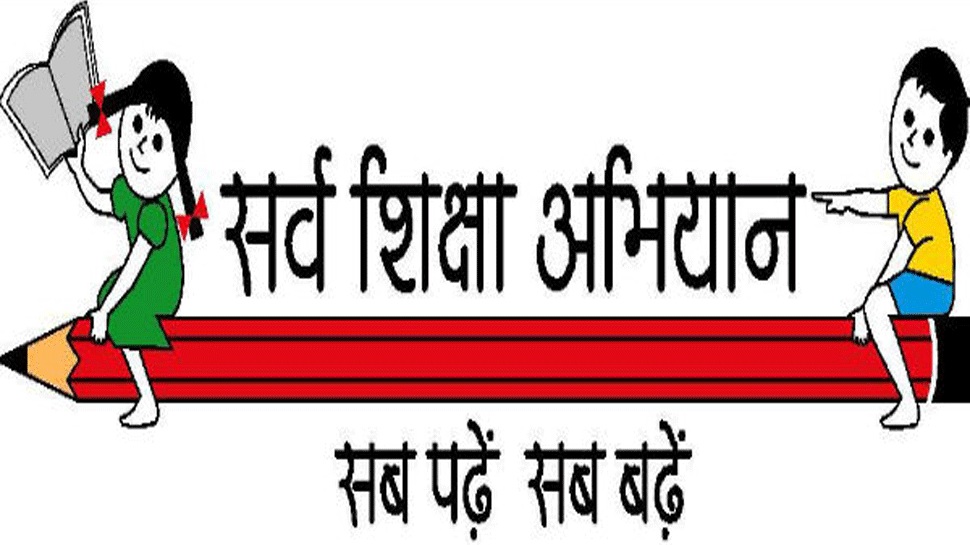
Project On Sarva Shiksha Abhiyan For Class 9
Introduction To Sarva Shiksha Abhiyan
The Sarva Shiksha Abhiyan (SSA), the government of India’s premier programme, was introduced in 2001 with the intention of providing universal basic education to all kids between the ages of 6 and 14. The approach aimed to promote social equality and close the educational gap between the wealthy and the poor.
The main objective of the Sarva Shiksha Abhiyan is to ensure that all children receive excellent education and that no child is left behind because of social, economic, or other factors. The major goals of the programme are to enrol out-of-school children, reduce dropout rates, and enhance classroom education.
The federal government and the states each provide a portion of the funding for the initiative, which is administered in collaboration with state governments. The strategy reduced social and gender gaps in educational outcomes while also enhancing access to education.

Objectives And Goals Of The Sarva Shiksha Abhiyan
The main objectives of the Sarva Shiksha Abhiyan are:
Universal Access: To guarantee access to education for all children between the ages of 6 and 14.
Universal Enrollment: Ascertain that each child is registered for and regularly attends school.
Retention: Increasing the proportion of students who register in more courses while decreasing the dropout rate is retention.
Quality: By offering a sufficient infrastructure, qualified teachers, and top-notch instructional materials, schools can improve the quality of education they deliver.
Equity: Reduced socioeconomic class, gender, and other inequalities in educational results are the goal of equity.
Community Participation: promoting community involvement in education and family involvement in a child’s education.
Focus on Girls’ Education: To ensure that females have equal access to and completion of basic school, a focus on girls’ education is required.
The Goals Of The Sarva Shiksha Abhiyan Are:
- To guarantee that every child receives a top-notch education and the skills necessary for a happy, prosperous life.
- To lower the dropout rate and boost student retention.
- To ensure that every child has access to an environment that is both safe and helpful for learning.
- To entice girls, children with disabilities, youngsters from disadvantaged social and economic circumstances, and members of other excluded groups to enrol in school.
- To improve instructors’ capacity to improve classroom instruction.
The accomplishment of these objectives and goals has benefitted social equality progress as well as India’s educational system improvement.
Key Features Of Sarva Shiksha Abhiyan
Inclusive Education: By ensuring that all children, including those with disabilities and residents of underprivileged communities, have access to education, Sarva Shiksha Abhiyan seeks to strengthen inclusive education.
Community Involvement: The curriculum encourages community involvement by incorporating parents, local communities, and civil society organisations in the creation and delivery of educational projects.
Curriculum Renewal: The importance of upgrading the curriculum to make it more relevant and adaptable to the changing needs of society is heavily emphasised by Sarva Shiksha Abhiyan.
Enhancement of Quality: The plan strives to enhance the quality of education by providing adequate facilities, qualified instructors, and top-notch instructional tools.
Girls’ Education: Recognising the value of promoting girls’ education, the Sarva Shiksha Abhiyan provides a range of incentives to encourage girls to enrol in and attend school.
Enhancing Teacher Education: Through in-service training, the provision of teacher resource materials, and support for pre-service teacher education, the plan lays a lot of emphasis on enhancing teachers’ abilities.
Monitoring and Evaluation: An excellent monitoring and evaluation system is in place for the Sarva Shiksha Abhiyan to ensure that the program’s objectives are met and that it is running effectively.
Financial Support: The plan provides financial support to states so they may achieve their educational goals, including opening new schools, purchasing classroom supplies, and paying teachers’ wages.
These core principles of the Sarva Shiksha Abhiyan have considerably promoted social equality and raised educational standards in India.
IMPLEMENTATION OF SARVA SHIKSHA ABHIYAN IN INDIA

The Sarva Shiksha Abhiyan is being carried out in collaboration with the federal and state governments. Each stage of the program’s implementation lasts a different amount of time.
The initial phase of the Sarva Shiksha Abhiyan started in 2001 and lasted through 2004–2005. The second phase, which lasted from 2005–2006 to 2009–2010, was launched at that time. The third phase began in 2010, and it continued through 2014. The fourth stage began in 2014 and continued until 2019 or 2020.
The Sarva Shiksha Abhiyan’s execution is reliant on a number of factors, such as:
Universal Enrollment: The goal of the plan is to guarantee that each child is enrolled in school and regularly attends. Numerous actions are done to achieve this, such as the opening of new schools, the upgrading of existing ones, and the offering of parent incentives.
Infrastructure Development: The construction of new school buildings, as well as the provision of furniture, bathrooms, drinking water facilities, and other amenities, are the Sarva Shiksha Abhiyan’s main priorities.
Teacher In-Service Training: The project provides in-service training for teachers to aid in their professional development and raise the calibre of instruction provided in classrooms.
Curriculum Renewal: The importance of upgrading the curriculum to make it more relevant and adaptable to the changing needs of society is heavily emphasised by Sarva Shiksha Abhiyan.
Focus on Girls’ Education: To promote the enrollment and retention of girls in school, the plan provides a range of incentives, including free textbooks, uniforms, and bicycles.
Monitoring and Evaluation: The initiative includes a robust monitoring and evaluation mechanism to ensure that its objectives are met and that it is working effectively.
Financial Support: The plan provides financial support to states so they may achieve their educational goals, including opening new schools, purchasing classroom supplies, and paying teachers’ wages.
Reduced dropout rates and improved access to school are results of the Sarva Shiksha Abhiyan. The program’s objectives must still be met, particularly those that deal with delivering high-quality education and reducing disparities based on gender, socioeconomic position, and other factors.
Progress And Achievements Of Sarva Shiksha Abhiyan
The Sarva Shiksha Abhiyan has made substantial advancements to the Indian educational system since its creation and has accomplished a number of significant milestones. Important advancements and successes include:
Increased Enrollment: School enrollment rates have increased dramatically as a result of the Sarva Shiksha Abhiyan, with the Gross Enrollment Ratio (GER) increasing from 87.5% in 2000 to 96.7% in 2019.
Reduced Dropout Rates: The Net Enrollment Ratio (NER), which increased from 68.3% in 2001 to 97.2% in 2019, indicates that the programme has also reduced the dropout rate.
Focus on female education: The Gender Parity Index (GPI), which rose from 0.75 in 2000 to 0.98 in 2019, indicates that the Sarva Shiksha Abhiyan has led to significantly more female pupils enrolling in schools.
Infrastructure Improvement: Thanks to the plan’s significant upgrades to schools’ physical facilities, more of them now have access to the most fundamental conveniences like bathrooms, running water, and electricity.
Quality Improvement: The Sarva Shiksha Abhiyan has made improving the level of instruction provided in schools a top priority. A number of actions have been done to achieve this, including providing teacher training, revising the curriculum, and applying cutting-edge teaching methods.
Reduction in Social Disparities: Social disparities in access to education have been lessened thanks to the program, which has also dramatically raised enrolment rates for children from low-income communities.
In general, the Sarva Shiksha Abhiyan has been successful in enhancing educational opportunities and reducing educational inequities based on gender, socioeconomic class, and other factors. More work needs to be put forth in order to guarantee that every child receives a top-notch education and to raise the bar for education.
Challenges And Limitations Of The Sarva Shiksha Abhiyan
Despite the enormous strides made by the Sarva Shiksha Abhiyan to increase educational access and reduce inequality, there are still a number of challenges and limitations that must be solved. The following are some of the major challenges and limitations:
Education level: Despite the program’s heavy emphasis on raising classroom instruction standards, there are still considerable differences between the quality of education provided in public and private schools.
Infrastructure Issues: Despite significant infrastructure upgrades made as part of the project, many schools still lack essential facilities like power, running water, and bathrooms.
Teacher Shortage: There is a teacher shortage in some areas of the nation, which has an effect on the calibre of instruction given in classrooms.
Gender Inequalities: Even though the programme was successful in getting more females enrolled, there are still significant gender discrepancies in access to education, particularly in rural areas.
Poor Implementation: Because of implementation problems, certain states have had difficulty implementing the initiative at the state level.
Limited Focus on Vocational Education: The strategy undervalues vocational education, a crucial element in boosting employability, and overemphasizes academic training.
Limited Funding: Despite the government’s substantial commitment in the plan, more money is still required to fill the gaps and remove the obstacles.
For the initiative to achieve its objectives of ensuring that all children have access to a basic education and enhancing the grade of instruction in schools, it is typically essential to overcome these challenges and limitations.
The Sarva Shiksha Abhiyan’s Effects And Benefits On Indian Education

There are numerous methods to evaluate how the Sarva Shiksha Abhiyan has considerably improved India’s educational system. Important results and benefits include:
Better Access to Education: The program’s higher enrollment rates and lower dropout rates have made it possible for more children to attend school.
Lessening of Gender Disparities: The programme has also assisted in reducing gender disparities in access to education as more girls register in school.
Infrastructure Improvement: Thanks to the programme, more schools now have access to the most fundamental conveniences, like lavatories, running water, and electricity.
Quality Improvement: As a result of the plan’s emphasis on improving the quality of education provided in classrooms, several initiatives, including teacher training programmes and curricular revisions, have been implemented.
Employability Has Risen: As more children pursue education and occupational training as a result of the strategy, employability has increased.
Reduction in Social Disparities: Reduced social disparities in access to education as a result of the program’s increased school attendance among children from disadvantaged communities.
Benefits to the Economy: The strategy has improved literacy rates, which are essential for the expansion and development of the economy. Economic prosperity depends on education.
The Sarva Shiksha Abhiyan has increased the proportion of children who receive high-quality education overall, considerably reduced gender and societal inequities, and enhanced access to school.
Future Plans And Directions For Sarva Shiksha Abhiyan
Although the programme has made significant progress in these areas, there is still a long way to go before the Sarva Shiksha Abhiyan’s objectives of achieving universal access to basic education and improving the calibre of instruction in classrooms are realised. The program’s future plans and directions include, among other things:
Focusing on Quality Improvement: The plan must place more attention on raising the standard of instruction delivered in schools, with a focus on teacher preparation, curriculum reform, and assessments in particular.
Closing physical Gaps: Many schools still lack basic facilities like power, running water, and toilets, despite significant physical improvements achieved during the endeavour. The initiative must repair these gaps to ensure that all schools have access to basic utilities.
Focus on Vocational Education: The strategy needs to place more of an emphasis on vocational education in order to boost employability and ensure that children have the skills required for the job market.
Improving Governance and Execution: Good governance and execution are essential to the program’s success, thus it’s necessary to deal with the problems and limitations there.
Increasing Funding: The government has made considerable contributions to the plan, but further funding is still required to fill up any gaps and address any problems.
Utilization of technology: The programme might utilise technology more effectively to increase access to education, particularly in rural and remote areas.
If the plan is to be successful in accomplishing its objectives and ensuring that all Indian children receive a top-notch education, then these long-term aims and orientations must be addressed.
Comparison Of Sarva Shiksha Abhiyan With Other Education Initiatives In India
In addition to the Sarva Shiksha Abhiyan, the Indian government has started a number of additional educational initiatives. In the area of education, other important projects include:
Rashtriya Madhyamik Shiksha Abhiyan (RMSA): The goal of the Rashtriya Madhyamik Shiksha Abhiyan (RMSA) programme is to raise the calibre and accessibility of secondary school instruction for all students.
Mid-Day Meal Plan: This initiative provides cooked lunches to students at public and government-aided schools in an effort to raise enrolment, retention, and attendance rates.
National Program of Education for Girls at Elementary Level (NPEGEL): This plan, known as the National plan of School for Girls at the Elementary Level (NPEGEL), focuses on educating girls in rural regions in an effort to reduce the gender access to school gap.
National Skill Development Mission: A campaign called the National Skill Development Mission aims to improve young people’s employability and occupational skills.
All of these programmes are intended to enhance the Indian educational system, but the Sarva Shiksha Abhiyan stands out as a comprehensive plan that emphasises raising the bar for fundamental education standards and making it available to everyone. Other jobs are important, but often have more definite and confined objectives.
The Sarva Shiksha Abhiyan has achieved its objectives, as evidenced by a noticeable increase in enrolment rates, a substantial fall in dropout rates, and improvements to school infrastructure and academic levels. In recognition of the program’s extensive success, the United Nations Educational, Scientific, and Cultural Organisation (UNESCO) designated Sarva Shiksha Abhiyan as one of the world’s best educational programmes.
Despite the fact that there are other notable education-related projects in India, the Sarva Shiksha Abhiyan remains to be the nation’s flagship endeavour to improve its educational system and guarantee that all children have access to a high-quality education.
Conclusion
The Sarva Shiksha Abhiyan is an important initiative of the Indian government that aims to improve classroom instruction and make primary education accessible to all students. Since the program’s start in 2001, enrolment rates have grown significantly, dropout rates have decreased, and academic standards and school infrastructure have both improved.
The plan still faces a number of challenges and limitations despite the improvements, such as the need for additional focus on quality improvement and inadequate infrastructure in some institutions. However, the program’s benefits and impact are significant because millions of children who might not otherwise have had the opportunity to attend school now can.
The program’s issues and limitations must be resolved in order for the future plans and orientations suggested by this project to fully move towards its goals. The program’s success will be vital in ensuring that all children in India have access to high-quality education and are given the skills and knowledge they need to succeed in life.
Overall, the Sarva Shiksha Abhiyan is a significant undertaking that will improve India’s educational system over the long term.
Certificate
This is to certify that I, [Your Name], a student of Class 9 at [Your School Name], have successfully completed the project on “Sarva Shiksha Abhiyan. ” The project was undertaken as a part of my academic curriculum to explore and understand the importance of this premier government initiative aimed at providing universal basic education to children between the ages of 6 and 14.
During the course of this project, I delved into various aspects of Sarva Shiksha Abhiyan, including its objectives, goals, key features, implementation, achievements, challenges, and future plans. I learned about the significance of promoting social equality, improving educational access, and enhancing the quality of education in India.
Through extensive research, I gained insights into the impact of Sarva Shiksha Abhiyan on the Indian educational system, such as increased enrollment rates, reduced gender disparities, improved infrastructure, and enhanced employability. Moreover, I discovered the challenges that the program faces and the need for continuous improvement to achieve its objectives fully.
I express my sincere gratitude to my subject teacher, [Teacher’s Name], for guiding me throughout the project and providing valuable feedback and encouragement at every stage. Additionally, I would like to thank my parents for their unwavering support and the school administration for granting me the opportunity to explore and learn through this project.
I am thrilled to have completed this project, and it has been a rewarding experience to study the Sarva Shiksha Abhiyan from a student’s perspective. This project has not only enriched my knowledge but has also inspired me to become an advocate for quality education and equal opportunities for all children.
Date: [Date]Place: [Your City] [Your Signature](Your Name)
In order to download the PDF, You must follow on Youtube. Once done, Click on Submit
Follow On YoutubeSubscribed? Click on Confirm
Download Project On Sarva Shiksha Abhiyan For Class 9 PDF






